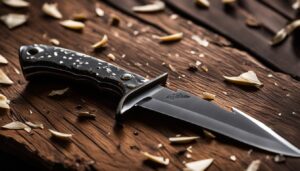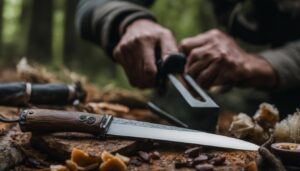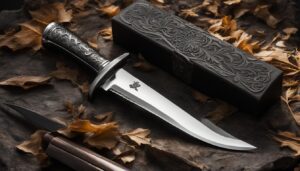To retain the sharpness of your hunting knife and preserve its cutting efficiency in the field, it is crucial to maintain its sharpness. Dull blades can hinder your performance and affect the quality of your cuts. By using in-field sharpeners and following proper sharpening techniques, you can ensure that your hunting knife remains sharp and precise.
Key Takeaways:
- Maintaining the sharpness of your hunting knife is essential for optimal performance in the field.
- Using in-field sharpeners, such as handheld carbide and ceramic sharpeners, or proper sharpening stones, can help you maintain a keen edge.
- The Work Sharp Field Sharpener 2.2.1 is a recommended choice for its sharpening guide and ceramic rod for honing.
- Different knives require different angles for sharpening, so it’s important to know the recommended angles for your specific knife.
- Performing regular maintenance at home, including sharpening your knife after each use and performing the thumbnail test to check sharpness, ensures that your knife is always ready for the field.
Preparing Your Knives at Home
Properly preparing your hunting knives at home is crucial to ensure their optimal performance in the field. By sharpening your knives after each use and maintaining their sharpness, you can enhance your cutting precision and efficiency during outdoor adventures. Let’s explore some essential techniques and tips for knife maintenance at home.
Sharpening Techniques
Sharpening your knives at home requires a few simple steps to restore their sharp edge. Start by selecting the appropriate angle for your specific knife. For example, a 20-degree angle is recommended for filet knives, while a 25-degree angle works well for hunting knives. Use coarse sharpening stones to remove any nicks or dullness from the blade, gradually progressing to finer stones for a polished edge.
To test the sharpness of your knife, you can perform the thumbnail test. Place the knife’s edge perpendicular to your thumbnail and slowly rotate it with gentle pressure. If the blade easily bites into your nail without slipping, it is sufficiently sharp. Otherwise, continue sharpening until the desired level of sharpness is achieved.
Storage and Maintenance
Properly storing your knives is essential to maintain their sharpness. After sharpening, make sure to clean the blade thoroughly to remove any debris or residue. Dry the knife completely before storing it in a sheath or knife block to prevent moisture buildup, which can lead to rusting.
Additionally, consider using protective blade covers or edge guards to prevent accidental dulling or damage when storing or transporting your knives. Regularly inspect your knives for any signs of wear or damage, such as loose handles or bent blades, and address them promptly to maintain optimal performance.
| Sharpening Angle | Sharpening Stones | Storage Tips |
|---|---|---|
| Filet knives: 20-degree angle | Coarse to fine stones | Clean and dry before storage |
| Hunting knives: 25-degree angle | Regular maintenance | Use blade covers or edge guards |
By following these tips for preparing and maintaining your knives at home, you can ensure that they remain sharp and ready for your next outdoor adventure.
Maintaining Sharpness in the Field
When it comes to hunting or fishing in the field, maintaining the sharpness of your knife is essential for optimal performance. A dull blade can make your tasks more challenging and increase the risk of accidents. That’s why it’s crucial to have an in-field knife sharpening tool that allows you to keep your knife sharp wherever your adventures take you.
One reliable option for in-field sharpening is the Guided Field Sharpener (GFS). This compact and portable tool is designed specifically for outdoor enthusiasts. The GFS typically comes equipped with coarse and fine diamond plates for sharpening, as well as a ceramic hone for touch-ups. With the GFS, you can easily restore and maintain a razor-sharp edge on your hunting knife, ensuring effortless cutting and clean, precise cuts.
During field dressing, it’s recommended to sharpen your knife multiple times to maintain optimal sharpness. The GFS provides a guided sharpening experience, allowing you to sharpen your knife at the correct angle consistently. This ensures that you achieve the desired sharpness and edge retention while minimizing the risk of damaging your blade. With the Guided Field Sharpener, you can have confidence in the performance of your knife, knowing that it’s always ready for action.
Choosing the Right Tools for Outdoor Knife Sharpening
When it comes to outdoor knife sharpening, having the right tools is essential. Whether you prefer guided sharpening options or freehand sharpening, selecting the appropriate tools can make a significant difference in the sharpness and longevity of your blades.
Guided Sharpening Options
Guided sharpening systems provide a fixed angle, ensuring consistent and secure sharpening. These systems are ideal for those who are new to sharpening or prefer a more controlled approach. The Lansky BladeMedic and the Work Sharp Guided Field Sharpener are popular choices for outdoor enthusiasts.
| Guided Sharpening Tools | Features |
|---|---|
| Lansky BladeMedic | – Compact and portable design – Offers multiple sharpening options: carbide, ceramic, and diamond tapered rod – Suitable for various blade types and serrated knives |
| Work Sharp Guided Field Sharpener | – Includes diamond plates for coarse and fine sharpening – Features a ceramic hone for touch-ups – Portable and easy to use in the field |
Free Sharpening Options
If you prefer more flexibility in choosing the sharpening angle, free sharpening options such as sharpening stones and steels are a great choice. These tools allow you to customize the angle to suit your blade and personal preference. Popular options for outdoor knife sharpening include the Fallkniven Diamond Ceramic Whetstone, Skerper Pocket Stone, and DMT Diafold two-sided sharpening stone.
| Free Sharpening Tools | Features |
|---|---|
| Fallkniven Diamond Ceramic Whetstone | – Combination of diamond and ceramic surfaces for coarse and fine sharpening – Compact and lightweight design – Suitable for various blade types and sizes |
| Skerper Pocket Stone | – Two-sided sharpening stone with coarse and fine grits – Compact and easy to carry – Suitable for outdoor use and maintaining blade sharpness |
| DMT Diafold Two-Sided Sharpening Stone | – Features both fine and coarse diamond surfaces – Folding design for easy storage and portability – Ideal for outdoor enthusiasts and maintaining sharp edges |
When choosing the right tools for outdoor knife sharpening, it’s essential to consider the type of steel your knife has. Different steels have different levels of hardness, and certain sharpening tools may be better suited for specific steel types. Understanding your knife’s steel composition will help you select the most effective sharpening tool and technique for optimal results.
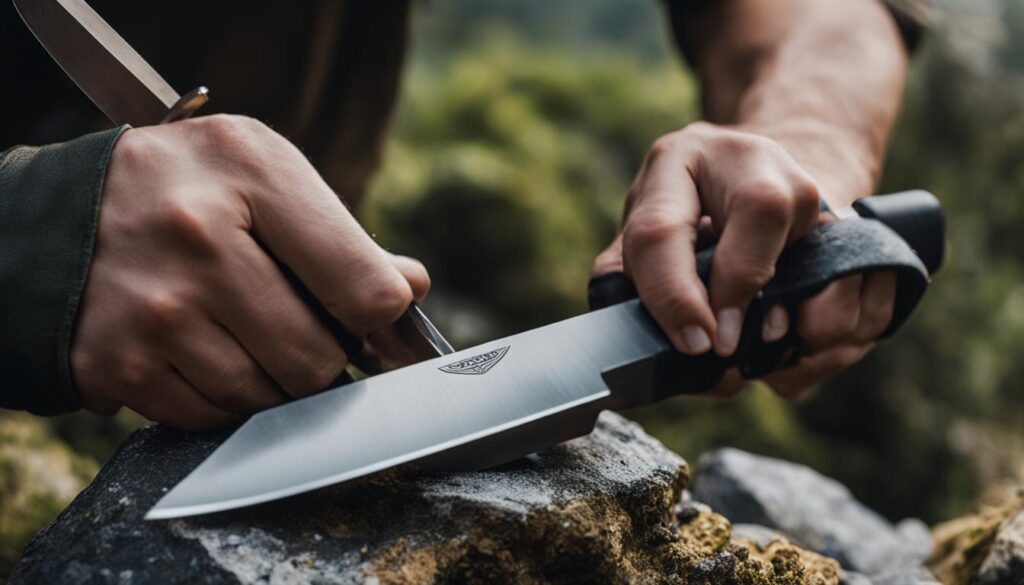
By choosing the appropriate tools for outdoor knife sharpening, whether guided or freehand, you can ensure that your blades remain sharp and ready for any adventure. Take the time to invest in quality sharpening tools that suit your needs and always follow proper techniques and safety precautions to maintain the longevity of your knives.
Sharpening Knives on the Road with Minimal Means
When you’re out on the road, it’s important to have portable and efficient sharpening tools to keep your knives razor-sharp. Whether you’re on a camping trip, hunting expedition, or simply exploring the great outdoors, having a reliable method of sharpening your knives is crucial. Here are some portable sharpening options that you can consider:
1. Fallkniven DC4
The Fallkniven DC4 is a compact sharpening stone that is perfect for outdoor use. It features a diamond side for coarse sharpening and a ceramic side for fine sharpening. This dual-sided design allows you to restore a dull knife to its original sharpness with ease. The Fallkniven DC4 is lightweight, easy to carry, and can be used with water or oil for optimal results.
2. Skerper Pocket Stone
The Skerper Pocket Stone is another excellent choice for sharpening your knives on the road. This portable sharpening stone is small enough to fit in your pocket or backpack, making it perfect for outdoor adventures. With its compact size, you can easily maintain the sharpness of your knives wherever you go. The Skerper Pocket Stone is a versatile tool that can be used with water or oil, depending on your preference.
3. Skerper Arkansas Pocket Stone
If you prefer using natural sharpening stones, the Skerper Arkansas Pocket Stone is a great option. Made from genuine Arkansas novaculite, this portable stone provides excellent sharpening performance. It has a fine grit that is perfect for maintaining the sharpness of your knives while on the road. The Skerper Arkansas Pocket Stone is lightweight and compact, making it a convenient tool for outdoor knife sharpening.
With these portable sharpening options, you can ensure that your knives remain sharp and ready for any outdoor task. Whether you’re camping, hiking, or hunting, having a sharp knife is essential for safety and efficiency. Invest in a reliable portable sharpening tool and enjoy the benefits of a razor-sharp blade wherever your adventures take you.
| Sharpening Tool | Description |
|---|---|
| Fallkniven DC4 | A compact sharpening stone with a diamond side for coarse sharpening and a ceramic side for fine sharpening. Can be used with water or oil. |
| Skerper Pocket Stone | A small and portable sharpening stone that fits easily in your pocket or backpack. Can be used with water or oil. |
| Skerper Arkansas Pocket Stone | A natural sharpening stone made from genuine Arkansas novaculite. Lightweight and compact. |
Stropping for Additional Sharpness
Stropping is a highly effective technique for maintaining and enhancing the sharpness of your hunting knife. By running the knife’s edge along a leather belt or strop, you can refine and polish the blade, resulting in increased sharpness. Regular stropping can extend the time between sharpening sessions and keep your knife razor-sharp, ensuring optimal performance in the field.
There are several portable stropping options available that are perfect for on-the-go sharpening. One popular choice is the Skerper Pocket Strop, a compact and lightweight tool that can easily fit in your pocket or backpack. Made with high-quality leather, the Skerper Pocket Strop provides a smooth surface to restore and maintain the edge of your knife. Another excellent option is the Brommeland Gunleather Pocket strop, which is specifically designed for hunters and outdoor enthusiasts.
When using a strop, it’s important to remember the proper technique. Hold the strop firmly and place the blade’s edge against the leather at the desired angle. With light pressure, swipe the knife back and forth along the entire length of the strop, maintaining a consistent angle. Repeat the process several times on each side of the blade to achieve the desired sharpness.
Stropping is a quick and efficient method to keep your knife in peak condition. It not only sharpens the blade but also helps remove micro-burrs, improving edge retention. Incorporating stropping into your knife maintenance routine will ensure that your hunting knife remains sharp and ready for any task in the field.
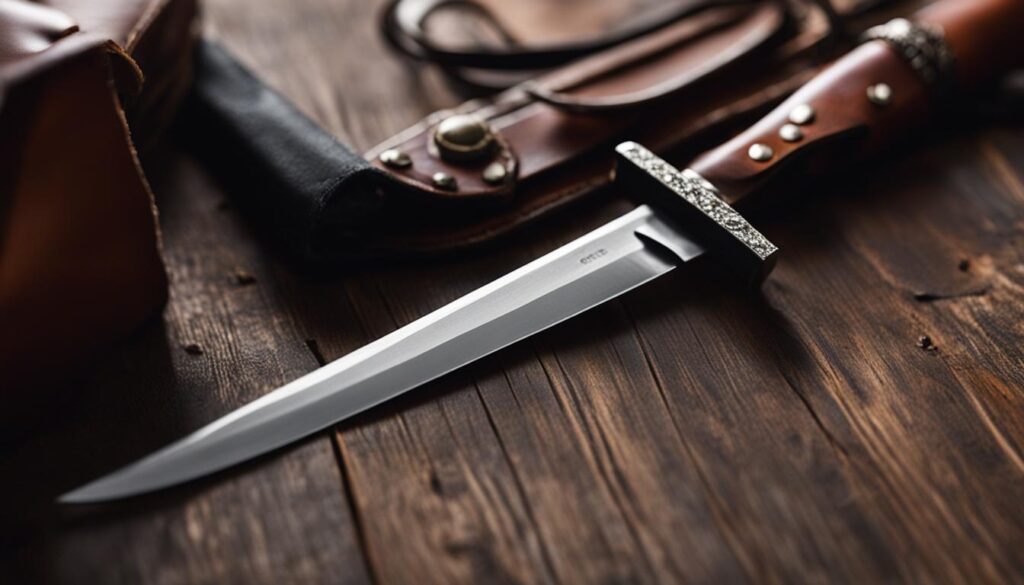

Benefits of Stropping:
- Enhances sharpness and cutting performance
- Removes micro-burrs for better edge retention
- Extends time between sharpening sessions
- Restores and maintains the edge of your knife
How to Strop:
- Hold the strop firmly and place the blade’s edge against the leather at the desired angle.
- With light pressure, swipe the knife back and forth along the entire length of the strop, maintaining a consistent angle.
- Repeat the process several times on each side of the blade to achieve the desired sharpness.
By incorporating stropping into your knife maintenance routine, you can ensure that your hunting knife remains in optimal condition, providing you with the precision and performance you need in the field.
Conclusion
In conclusion, maintaining a sharp hunting knife is crucial for ensuring precision and efficiency in the field. By using in-field sharpeners and properly maintaining your knives at home, you can retain the sharpness of your blade and preserve its cutting power.
Choosing the right tools for outdoor knife sharpening is key. Whether you opt for guided sharpening options like the Lansky BladeMedic or prefer the flexibility of free sharpening tools such as the Fallkniven Diamond Ceramic Whetstone, it’s important to consider the type of steel your knife has to select the appropriate tool.
Lastly, incorporating stropping into your knife maintenance routine can further enhance the sharpness of your blade. Regular stropping with tools like the Skerper Pocket Strop can extend the time between sharpening sessions and keep your knife razor-sharp.
In summary, by following these techniques and using the right tools, you can maintain a keen edge on your hunting knife, enhancing your outdoor experiences. Taking the time to properly sharpen and maintain your knife will ensure that it performs at its best when you need it most.
FAQ
How often should I sharpen my hunting knife?
It is recommended to sharpen your hunting knife after each use to ensure optimal performance in the field.
What angle should I sharpen my hunting knife at?
For hunting knives, a 25-degree sharpening angle is generally recommended.
How can I tell if my knife is sharp enough?
You can perform the thumbnail test by placing the edge perpendicular to your nail and slowly rotating it with light pressure. If it catches or digs into your nail, it is sharp.
What is the difference between guided and free sharpening options?
Guided sharpening options provide a fixed angle for consistent sharpening, while free sharpening options offer more flexibility in choosing the sharpening angle.
What type of sharpening tool should I use for my knife?
It is important to consider the type of steel your knife has before selecting a sharpening tool. Popular options include diamond ceramic whetstones, pocket stones, and two-sided sharpening stones.
Can I sharpen my knives while on the go?
Yes, there are compact and portable sharpening tools available for sharpening knives on the road, such as pocket stones and sharpening pens.
What is stropping?
Stropping is a technique used to maintain and enhance the sharpness of a knife. It involves running the knife’s edge along a leather belt or strop to refine and polish the edge.
How often should I strop my knife?
Regular stropping can extend the time between sharpening sessions. It is recommended to strop your knife as needed to keep it razor-sharp.


